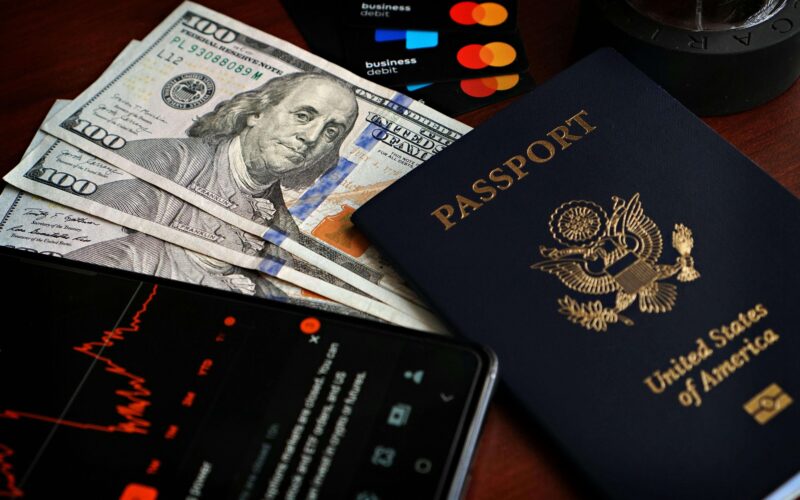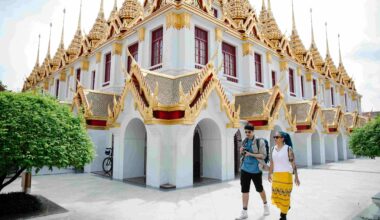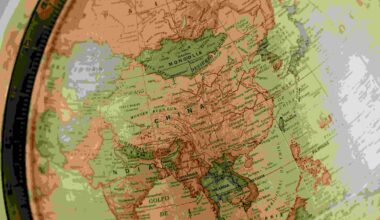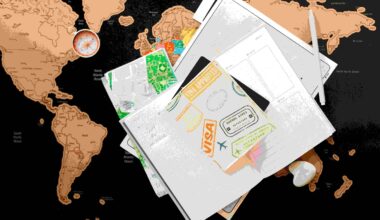In this post, we will walk you through best guide for visa application for USA.
The United States has long stood as a land of opportunity , whether for quality education, career growth, medical visits, or simply experiencing its rich culture. Yet, the very path that leads there begins with visa.
What many don’t realize is that a U.S. visa isn’t a guarantee of entry, it’s simply a pass that allows you to approach the border.
The real journey starts with understanding the process, choosing the right visa type, and preparing for the interview that could make or break your plans. Unfortunately, a lot of applicants stumble not because they’re unqualified, but because they approach the process without the right guidance.
This guide is designed to simplify the maze, clear the myths, and walk you step-by-step through the best way for visa application for USA.
If you’re a student chasing academic dreams, a professional eyeing career advancement, or a tourist longing to see the Statue of Liberty, this post will equip you with the knowledge and confidence to face the journey ahead.
Understanding Why You Need a Visa
Before you can step onto American soil, there’s one golden key you must secure which is the visa. Many first-time travelers assume a visa is just a stamp that guarantees entry, but that’s a common misconception.
A U.S. visa does not automatically mean you’re free to walk into the country, it simply gives you permission to travel to a U.S. port of entry, like an airport, and ask the Customs and Border Protection officers for permission to enter.
Visa application for USA is like buying a ticket to a concert and the ticket gets you to the gate, but the security team decides if you actually get in.
Now, why exactly do you need one? The United States uses the visa system to manage and monitor the purpose of your visit to know if you are coming to study, to work, to tour, or to stay permanently. The type of visa you apply for defines your story in the eyes of the U.S. government.
For instance, if you’re a Nigerian student eager to pursue your Master’s in Texas, your path will be the student visa. If you’re a tourist planning to explore the magical lights of Las Vegas or visit family in Houston, the tourist visa is your route.
A skilled professional with a job offer from a U.S. company? You will be looking at a work visa. And for those hoping to relocate permanently, the journey begins with immigrant visas.
Choosing the right visa is not just paperwork, it’s the foundation of your entire travel plan. Apply for the wrong one, and you risk delays, denials, or even being barred from reapplying for a period of time.
But when you understand the purpose behind each visa category, you’re already a step ahead of most applicants who enter the process confused.
So, before you dream about skyscrapers in New York or careers in Silicon Valley, pause and ask yourself the most important question which is why am I going to the U.S.? The answer will determine the type of visa you need, and ultimately, how smooth your application journey will be.
The First Big Step: Choosing the Right Visa
Imagine standing at a crossroads with four different signposts. One points toward Tourist, another says Student, a third reads Work, and the last one boldly declares Immigrant.
Each path promises entry into the United States, but here’s the catch, you can’t walk them all at once. You must choose the one that truly matches your purpose. That choice is your visa type, and it is the very first big step in your application journey.
Many applicants stumble here because they apply for the wrong category. If you claim you’re traveling as a tourist when in reality you plan to study, the U.S. consular officer will quickly see the mismatch. It’s like showing up at an airport with a bus ticket, it simply doesn’t work.
The key is honesty and clarity. Ask yourself
- Am I going to the U.S. to study? Then you’re looking at a student visa.
- Am I visiting family, sightseeing, or attending a wedding? That’s the tourist visa.
- Did I land a job offer from a U.S. employer? Your path is a work visa, such as H-1B or H-2B, depending on the job.
- Do I plan to move permanently? That’s where immigrant visas or the Green Card Lottery come in.
Choosing the right visa is not about guessing, it’s about aligning your real purpose with the correct category. The U.S. system of visa application for USA is designed to filter intentions, so when your story doesn’t match your application, red flags go up immediately.
Here’s the truth: your visa type shapes every other step, from the form you will fill out (DS-160 or DS-260) to the interview questions you’ll face.
It’s the foundation of your journey, and once you get it right, the rest of the process becomes much clearer.
So before you move into filling forms or booking embassy appointments, take a moment to be certain. This isn’t just paperwork, it’s the roadmap to your American dream.
One wrong turn could send you back to square one, but the right choice will move you closer to that boarding gate with confidence.
Demystifying the DS-160 Form
If the visa application for USA journey were a movie, the DS-160 form would be the script. Every detail you provide tells your story to the consular officer long before you even walk into the embassy.
Yet for many first-time applicants, this form feels like a maze of endless questions, strange terms, and boxes that seem to trick you into making mistakes.
The DS-160 is an online application form required for all non-immigrant U.S. visas, from students to tourists to workers. It asks for everything such as your personal details, travel history, family background, education, work experience, and even social media handles.
Why? Because the U.S. government wants to know who you are, why you’re coming, and whether your story makes sense.
Here’s where the challenge comes in. Many people rush through it. They type in answers the way they would fill out a casual online survey, not realizing that every detail will be carefully cross-checked during the interview.
A small error, a misspelled name, a mismatched passport number, unclear travel dates can cause unnecessary delays, or worse, denial.
Imagine a young nurse from Lagos, who mistakenly swapped her middle name and surname on the form. At the interview, the consular officer immediately noticed the inconsistency with her passport. Her application will be put on hold until she corrected it, costing her both time and money.
The secret to conquering the DS-160 is patience and accuracy. Take your time. Double-check your details before submitting. Save the confirmation page with the barcode because you will need it to book your interview appointment. And remember, honesty is your best strategy.
The form is not the place to polish your story, rather it’s where you lay the foundation for credibility.
The DS-160 is not just paperwork, but your first conversation with the U.S. embassy. If you get it right, you walk into your interview with confidence. If you get it wrong, you might be answering questions you didn’t expect.
So don’t fear the DS-160, demystify it. Treat it with the seriousness of signing a contract, because in many ways, it is. Your future trip depends on it.
The Appointment and Fee Payment Journey
By the time you’ve conquered the DS-160 form, you probably feel like you’ve already run a marathon.
But here comes the part where your visa application for USA begins to take shape, paying the visa fee and booking your appointment. This is the stage where the dream starts to feel real and a little nerve-wracking.
Every applicant must pay the MRV fee (Machine Readable Visa fee), which is non-refundable. The amount depends on the visa category, but here’s the kicker: once you pay, there are no refunds, no transfers, and no changing your mind.
It’s buying a one-way ticket to an interview seat at the U.S. embassy.
In Nigeria, for example, the process often involves paying through designated banks or approved online platforms, and then keeping your receipt safe.
That slip of paper or electronic confirmation isn’t just a formality, it’s your golden proof when scheduling your appointment. Lose it, and you may find yourself retracing stressful steps.
Once the fee is paid, you’ll log into the U.S. visa appointment system to book your interview date. And this is where patience becomes your best friend.
Appointment slots can sometimes feel like scarce tickets to a sold-out concert. Depending on demand, you might wait weeks or even months to secure a date.
Imagine Ada, a postgraduate hopeful bound for Boston. She paid her MRV fee in excitement, only to find that the earliest available appointment was three months away.
The wait felt endless, but she used the time wisely to prepare her documents and practice potential interview questions. When her day finally came, she walked into the embassy calm and ready.
Don’t panic if the first available date looks far away. Secure it anyway. You can always check back for earlier slots as cancellations often happen. What matters most is that you’ve reserved your spot in the line.
This stage of the journey is both a test of patience and proof of commitment. It’s the point where your intention transforms into action, where you’ve literally put your money down and said I’ m ready.
So handle it carefully, pay correctly, keep your proof safe, and book as early as possible. From here on, every step brings you closer to that all-important interview, the moment where your American dream meets its first real gatekeeper.
The Interview Day: Facing the Consular Officer
This is the day you’ve been waiting and probably losing sleep for. After weeks of filling forms, paying fees, and checking your documents over and over, you finally arrive at the U.S. embassy.
The air feels different here. Nervous applicants shuffle in line, clutching folders like treasure chests, while others rehearse answers under their breath.
Security officers scan bags, phones are switched off, and before long, you find yourself seated in the waiting hall, heart pounding, and documents in hand.
In visa application for USA, visa interview is the decisive moment. But the truth is that it’s not a test of how well you can memorize answers.
The consular officer is trained to do one thing which is to confirm that your story, your documents, and your intentions all align. Their questions are short, direct, and often unexpected.
For instance, if you’re a student applying for an F-1 visa, you might hear a question like:
- Why did you choose this university?
- Who is sponsoring your studies?
- What do you plan to do after graduation?
If you’re a tourist, you may face questions like:
- Where will you be staying in the U.S.?
- Do you have family here?
- How long do you plan to stay?
The key is confidence and consistency. Nervousness is normal, but avoid over-rehearsed speeches that sound robotic. Instead, answer honestly and clearly.
Remember, the officer already has your DS-160 form in front of them. If your spoken answers contradict your written ones, that’s a red flag.
Also, don’t underestimate the non-verbal cues. The officer notices your body language as much as your words. Maintain eye contact, smile politely, and stay calm even if the officer looks stern.
They aren’t there to intimidate you, they’re there to make sure you’re a genuine traveler.
And not everyone will be asked for supporting documents, but always bring them anyway, proof of funds, admission letters, employment letters, or hotel bookings. It’s better to have them and not need them than to need them and not have them.
When the interview ends, the decision is often immediate: approved, denied, or pending administrative processing.
Whatever the outcome is, always remember that the interview isn’t about tricking you, it’s about verifying your story.
Walk in prepared, walk in truthful, and walk in with the mindset that you’re not begging for a visa, you’re simply proving that your reasons for travel are valid.
So, take a deep breath. This isn’t just a Q&A session, it’s the final step between you and the American dream.
After the Interview: The Waiting Game
The interview is over. You walk out of the embassy doors with your heart racing, replaying every answer you gave.
Some applicants leave smiling, clutching that small white slip that signals approval. Others walk away with heavy hearts, holding a denial notice. And then there are those caught in the middle, placed under administrative processing, left in limbo with no clear timeline.
Welcome to the stage every visa applicant dreads, the waiting game.
If your visa is approved, congratulations. You will usually be told when to expect your passport back with the visa stamped inside.
For many, this moment feels surreal, the dream of stepping into the U.S. is no longer just an idea, it’s becoming reality.
Still in the waiting period until your passport is returned then can feel like forever, especially when travel dates are close.
If your application was denied, it’s easy to feel crushed. But here’s the truth many don’t realize, a denial isn’t the end of the road. The U.S. consulate often gives a reason, usually linked to Section 214(b), meaning the officer wasn’t convinced you’ll return home after your trip.
That doesn’t mean you can never reapply, it means you need stronger proof of ties, clearer documents, or a more consistent story next time.
Countless people have been denied once, learned from the experience, and succeeded on their second or even third try.
And then there’s administrative processing, the gray area. Maybe the officer needs to verify certain details, or maybe your case requires extra background checks. This can take days, weeks, or sometimes months.
It’s frustrating, but it’s also a reminder that the process of visa application for USA is about thoroughness, not speed.
The best way to survive the waiting game is patience and preparation. Instead of refreshing your email every five minutes, use the time wisely.
Gather more supporting documents in case of reapplication. Start planning your travel budget. Prepare emotionally for both possible outcome, either approval or denial.
Remember, every successful U.S. visa holder once sat where you are, waiting with uncertainty. The outcome may not always be what you expect, but each step teaches you something valuable about persistence, preparation, and resilience.
So whether your passport comes back stamped with approval, or you face the sting of denial, know that the waiting game is just one chapter in your journey.
The bigger picture is your determination to chase opportunities, no matter how many times you’re asked to try again.
Conclusion
Applying for a U.S. visa is not just about paperwork and interviews, it’s an emotional journey filled with hope, anxiety, and determination.
From filling out the DS-160 form to facing the consular officer, every step tests your patience, your honesty, and your preparation. For many Nigerians, the process may feel intimidating, but remember that millions have walked this road successfully, and so you too can.
Yes, there may be setbacks. A denial can sting, and waiting for approval can feel endless. But each step, whether smooth or bumpy, teaches you valuable lessons about persistence and preparation.
A visa is not a measure of your worth, it’s simply a gateway to an opportunity. If the door doesn’t open the first time, you can always knock again and this time better prepared.
The secret lies in three things: clarity, honesty, and confidence. Be clear about your purpose, be honest in your story, and face the process with quiet confidence.
The consular officer isn’t searching for perfection, they’re searching for credibility. When your documents, answers, and intentions align, you give them every reason to say yes.
So, whether your dream is studying in Boston, working in Silicon Valley, or exploring the streets of New York, approach the journey with courage. Every successful U.S. visa holder was once where you are today waiting, uncertain, but determined.
Let that remind you that your American dream is valid, and with preparation and persistence, it’s within reach.
This post is the best for your guide on visa application for USA you would always like to read again.
Similar Post






